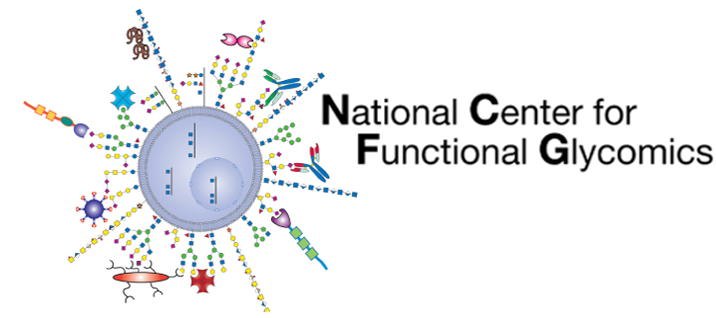By: Richard D. Cummings
Collagen is the most common and abundant glycoprotein in animals (1). Even sponges have collagen (termed spongin) and it is glycosylated much like mammalian collagen. Its name derives from the Greek κόλλα (kólla) (meaning "glue") and the suffix -γέν (-gen), denoting "producing" (Oxford English Dictionary). Collagen typically contains three polypeptide strands in a left-handed, polyproline II-type (PPII) helical conformation (1,2); the peptides contain the collagen triplets XaaYaaGly sequence, where Xaa and Yaa can be any amino acid. Collagens are a family of 28 different members, including I-XII and α chain variants, e.g., α1, α2, etc. In human skin, collagen (types I and III) make up about 2/3 of the dry weight (1,2).
A defining feature of the glycosylation of collagen is the presence of multiple hydroxylysine residues which are glycosylated as Glcα1-2Galβ1-O-hydroxyLys (the ‘collagen disaccharide’). This unusual structure was originally defined by Robert Spiro in 1967 (3). The Glc-Gal disaccharide structure appears to only occur in collagens and collagen-like glycoproteins (4). The biosynthesis of Glcα1-2Galβ1-O-hydroxyLys is complex, as it involves a hydroxylase activity which converts Lys to hydroxyLys and then two enzyme activities that use UDP-Gal and UDP-Glc to add Gal and Glc, respectively, to the hydroxyLys. There are several lysine hydroxylase (LH) activities present in the endoplasmic reticulum (ER) that are involved in hydroxyLys production; defects in hydroxylation of Lys are associated with Ehlers-Danlos syndrome type VI and Bruck syndrome (5). The addition of galactose to hydroxyLys is initiated in the ER by two Mn2+-dependent O-galactosyltransferases - GLT25D1 and GLT25D2 (4-6). Surprisingly, the identification of the collagen glucosyltransferase has been difficult, but it appears the activity is part of a larger enzyme activity that includes collagen hydroxylase as in the multifunctional collagen lysyl hydroxylases (LHs/PLODs), which have both Fe2+-dependent lysyl hydroxylase (LH) and Mn2+-dependent glucosyltransferase activities (7,8). Interestingly, the addition of Gal to collagen in the ER requires the presence of UDP-Gal in the ER. The UDP-Gal transporter is encoded by an X-link gene SLC35A2 (9). While the UDP-Gal transporter is also present in the Golgi apparatus, a splice variant leads to a transporter that is retained in the ER (10). Mutations in SLC35A2 are associated with a Congenital Disorder of Glycosylation (SLC35A2-CDG) (11), but so far no particular defects in collagen O-glycosylation have been identified.
Interestingly, the C-Pro domain of procollagen C-Pro has a single N-glycosylation site, which is highly conserved. The function of the N-glycan has been enigmatic, but recently it was found that it is required for folding and secretion of collagen under conditions where the proteostasis of the cell is challenged, as with mis-folding variants of collagen (12).
References
- Shoulders, M. D., and Raines, R. T. (2009) Collagen structure and stability. Annu Rev Biochem 78, 929-958
- Holmes, D. F., Lu, Y., Starborg, T., and Kadler, K. E. (2018) Collagen Fibril Assembly and Function. Curr Top Dev Biol 130, 107-142
- Spiro, R. G. (1967) The structure of the disaccharide unit of the renal glomerular basement membrane. J Biol Chem 242, 4813-4823
- Hennet, T. (2019) Collagen glycosylation. Curr Opin Struct Biol 56, 131-138
- Schegg, B., Hulsmeier, A. J., Rutschmann, C., Maag, C., and Hennet, T. (2009) Core glycosylation of collagen is initiated by two beta(1-O)galactosyltransferases. Mol Cell Biol 29, 943-952
- Perrin-Tricaud, C., Rutschmann, C., and Hennet, T. (2011) Identification of domains and amino acids essential to the collagen galactosyltransferase activity of GLT25D1. PLoS One 6, e29390
- Mattoteia, D., Chiapparino, A., Fumagalli, M., De Marco, M., De Giorgi, F., Negro, L., Pinnola, A., Faravelli, S., Roscioli, T., Scietti, L., and Forneris, F. (2023) Identification of Regulatory Molecular "Hot Spots" for LH/PLOD Collagen Glycosyltransferase Activity. Int J Mol Sci 24
- Wang, C., Luosujarvi, H., Heikkinen, J., Risteli, M., Uitto, L., and Myllyla, R. (2002) The third activity for lysyl hydroxylase 3: galactosylation of hydroxylysyl residues in collagens in vitro. Matrix Biol 21, 559-566
- Ishida, N., Miura, N., Yoshioka, S., and Kawakita, M. (1996) Molecular cloning and characterization of a novel isoform of the human UDP-galactose transporter, and of related complementary DNAs belonging to the nucleotide-sugar transporter gene family. J Biochem 120, 1074-1078
- Kabuss, R., Ashikov, A., Oelmann, S., Gerardy-Schahn, R., and Bakker, H. (2005) Endoplasmic reticulum retention of the large splice variant of the UDP-galactose transporter is caused by a dilysine motif. Glycobiology 15, 905-911
- Ng, B. G., Buckingham, K. J., Raymond, K., Kircher, M., Turner, E. H., He, M., Smith, J. D., Eroshkin, A., Szybowska, M., Losfeld, M. E., Chong, J. X., Kozenko, M., Li, C., Patterson, M. C., Gilbert, R. D., Nickerson, D. A., Shendure, J., Bamshad, M. J., University of Washington Center for Mendelian, G., and Freeze, H. H. (2013) Mosaicism of the UDP-galactose transporter SLC35A2 causes a congenital disorder of glycosylation. Am J Hum Genet 92, 632-636
- Li, R. C., Wong, M. Y., DiChiara, A. S., Hosseini, A. S., and Shoulders, M. D. (2021) Collagen's enigmatic, highly conserved N-glycan has an essential proteostatic function. Proc Natl Acad Sci U S A 118
